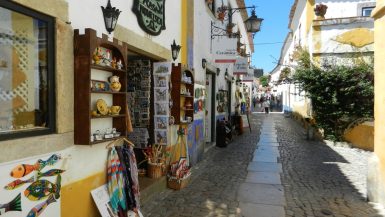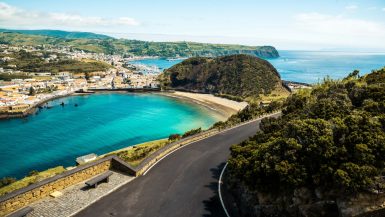
Are there sharks in Portugal? Yes, there are! With miles of rugged coastline on the Atlantic Ocean, it’s no surprise that there are around 40 species of sharks swimming in this stunning country’s waters. Luckily, it’s extremely rare to see these fearsome marine creatures in these parts, so there is no reason you should be worried about hitting the water in PT!
From beautiful sandy beaches along the Algarve to colorful, bustling cities such as Lisbon and Porto right by the sea, from beautiful vineyards scattered around the Douro Valley to great surf breaks in Peniche and beyond, Portugal has a lot up its sleeve. Millions of people head to this Western European country every summer, and most of them go straight to the coast.
While most holidaymakers won’t even come close to one of the beasts of the saltwater realm here, it doesn’t mean no sharks are lurking beneath the surface. This guide will answer the question “are there sharks in Portugal” by giving you a detailed list of seven species you may find prowling the shoreline.
The great white shark

Are there sharks in Portugal that could hurt you? Unfortunately, the answer to this question is yes. The infamous great white shark, which is responsible for the most attacks on people worldwide, live nearly across all seas and oceans, including the North Atlantic around Portugal. Luckily, you’re unlikely to see one…
The reason? They much prefer deeper parts of the ocean far away from the Portuguese coast, so it’s extremely unlikely you’d encounter one around the beaches. The chances slightly increase if you take a boat trip further afield, but still, sightings of great white sharks in Portugal are seldom to say the least.
They’re big and bulky sharks that typically grow to about 13-16ft. The white in their name refers to the distinct color of their underbellies. They’re dark grey on top, but the color drastically changes to a much brighter shade below. They have slightly pointed snouts and jaws lined with rows of serrated teeth.
The great white shark is considered very dangerous to humans, mainly because of their test bite that can cause serious, often fatal injuries. Despite the Jaws depiction as a man-hunter, these sharks aren’t actually that fond of human flesh. They much prefer rich and fatty seals, large fish like tuna, other sharks, and sea turtles.
Blue sharks

Blue sharks are actually one of the more common species that can be found in the waters around Portugal. They are often caught up in fishing nets and are known to inhabit the eastern Atlantic Ocean. In fact, they are found off the coast of every continent on the planet, bar Antarctica.
Blues are usually happier in the deeper waters of warmer seas but have been known to stray closer to the shoreline in places like Portugal, where they have even been spotted by people on scuba trips. They are medium-sized requiem sharks that typically grow to about 8 feet across. They’re mainly noticeable – just as the name implies – for their faint blue coloring.
This type of shark isn’t usually considered dangerous to humans. Bite incidents are rare, but the few that have been recorded are usually down to close and accidental encounters with fishermen or divers. Usually, blue sharks live on a diet of smaller fish, octopi, and crustaceans.
Shortfin mako shark

The Shortfin mako shark is also known as the bonito shark in some parts of the planet. It’s a common Atlantic Ocean shark that’s present around the northern part of Portugal and has been historically heavily fished here and in Spain, although there’s now an approaching ban on catches of this species.
Relatively large compared to other swimmers, these can hit 10 feet in length and weigh up to 300 pounds at full adulthood. They are mainly known for being among the fastest sharks in the water and can gather enough speed to make elaborate jumps during hunting frenzies.
Records show that there have been under 10 attacks on humans in the last 500 years, so they should hardly be considered dangerous a la the great white. Truth is, we pose a much greater threat to these guys than they to us. That’s because they’re highly sought after for their meat and are a major goal of sport fishers on account of that formidable speed.
Basking shark

The basking shark is by far the biggest shark you might see in the waters off Portugal. In fact, it is the second largest fish in the world, only smaller than the giant whale shark. They really are big, though! The most sizable adults can grow up to a whopping 36 feet long! Most individuals average between 23 and 30 feet and weigh around 4.65 tons.
Seeing this marine giant can make your heart go faster, but there is no need to panic. Basking sharks are harmless. They use their large mouths to scoop out tiny sea creatures that include zooplankton and very small fish, but they don’t feed on large animals like us.
You might be lucky enough to spot basking sharks close to the land. They often hang close to the surface where they follow plankton concentration. There was one very close to the Meia Praia Beach in Lagos back in 2018 and one spotted by passengers of a tour boat just off the coast of Praia da Ribeira do Cavalo in March 2019.
Smooth hammerhead shark

Hammerhead sharks are the most unique-looking sharks you might see off the coast of Portugal. You can easily tell them apart from other sharks by looking at their wide, flattened heads that resemble hammers. The one you’re most likely to see in the Portuguese waters is the smooth hammerhead.
Smooth hammerhead sharks prefer temperate waters around higher latitudes, including the Northern Atlantic Ocean that surrounds Portugal. Unlike other species in their family, they often stay close to the surface and rarely dive deep, which means you might be lucky enough to spot one.
You’ll recognize them by looking at their head, which is flat and extended at each side. It’s also slightly curved, which differentiates them from other hammerheads. Smooth hammerheads are the second largest in their family and can reach up to 11.5ft across.
Smooth hammerheads are potentially dangerous to humans, so you shouldn’t be tempted to swim close up if you spot one. That said, there have only been a handful of reported incidents across the globe, and only one of them was fatal. They mainly feed on bony fishes, rays, and other sharks.
Common thresher

The common thresher is also known as the Atlantic thresher, which should indicate that these fish dwell in the waters around Portugal. They’re migratory fish, so you may find them close to the shore or far away in the open ocean, depending on the time of the year. You will easily distinguish them from other sharks by looking at their uniquely long tail fin, which often accounts for half of the shark’s whole-body length!
The common thresher is the largest of all thresher sharks and can reach up to 19ft in length. That said, most adults don’t grow larger than 16ft and weigh no more than 510lb. They’re metallic purple-brown or grey on top with a whitish underbelly and blue sides. They also have white spots on some of their fins.
These are very timid creatures, which means they pose only a minimal threat to people. They tend to swim away quickly when they see divers, so it’s not easy to get close to them. Sadly, they are highly sought after by sport fishers who prize them for their fighting abilities, similar to those of the shortfin mako (see above). They’re also commercially fished, which means their numbers are decreasing.
Spiny dogfish

Dogfish are among the most common sharks you might see in Europe, and the spiny dogfish is one of the best known in its group. They live in shallow waters close to the shore and further out in the sea. That means it is the most likely species to spot while taking a dip during your Portuguese holiday. You will find them along the whole country’s coastline, no matter whether you’re visiting the beaches near Porto, Lisbon, or amid the beautiful Algarve.
This is a relatively small shark that can only grow to about four feet maximum. They have slim bodies and narrow, pointed snouts. You can recognize them by the characteristic white spots on their grey backs. They have two spines that allow them to pierce their predators in defense.
Due to the small size, spiny dogfish isn’t dangerous to humans, so there is absolutely nothing to worry about if you happen to see one while traveling in Portugal. They feed on small marine creatures that include squid, small fish, jellyfish, and crabs. In fact, it is people that have led to a massive decrease in dogfish numbers in European waters due to overfishing.
Are there sharks in Portugal – the conclusion.
Are there sharks in Portugal? Yes, but luckily most of them aren’t dangerous. There is a slim chance that you might come across the infamous great white, but it’s extremely unlikely. In fact, there were only eight reported shark attacks in the country’s whole history, so there is really nothing to worry about if you’re planning a beach holiday in the Algarve or along the wave-rich Silver Coast. Dogfish and blue sharks are among the most likely sharks you might see, but neither of the two poses much threat to people. Ah, and if you’re lucky, you might get to see one of the gentle giants of the ocean, the basking shark.


